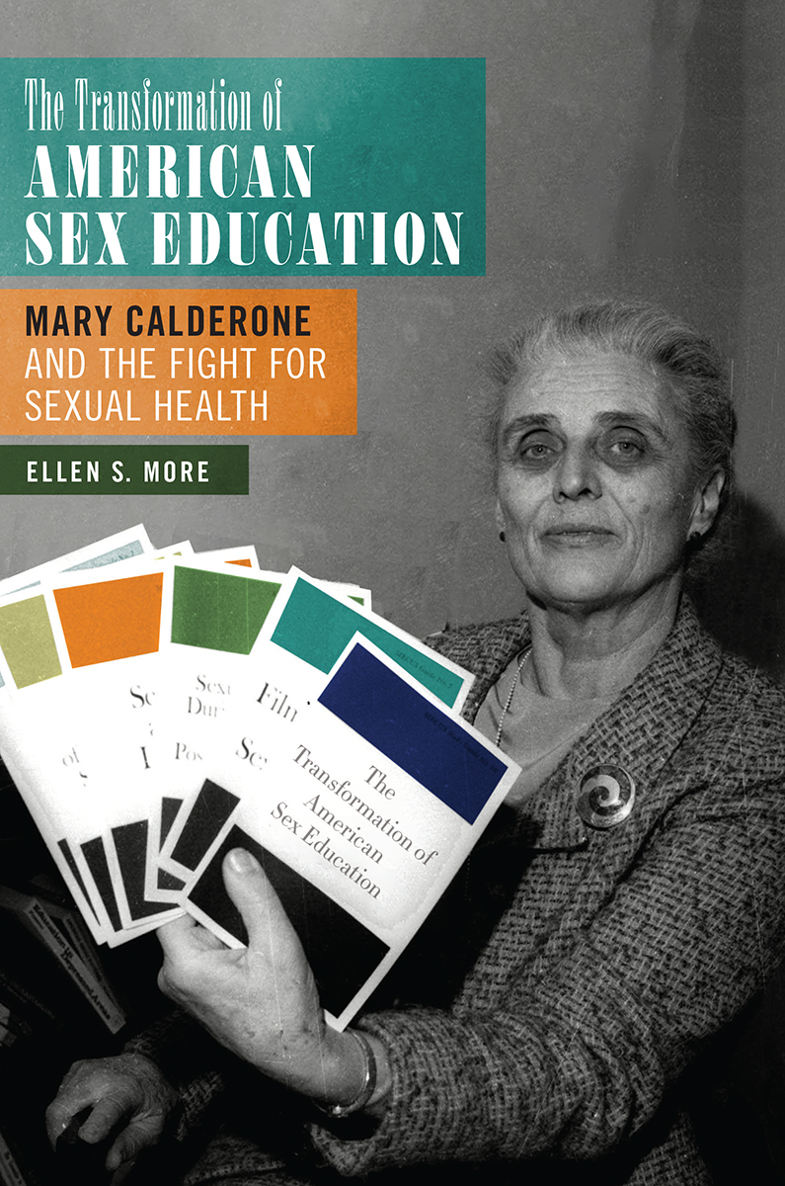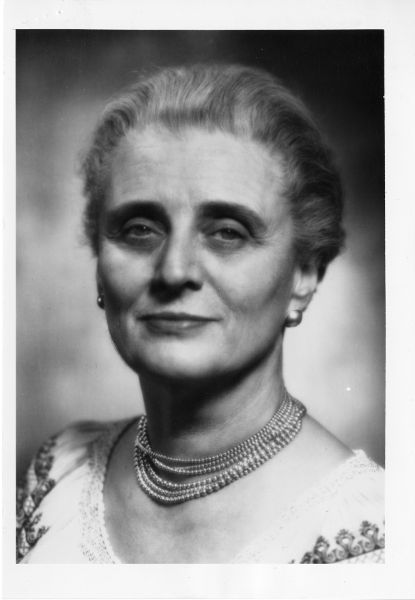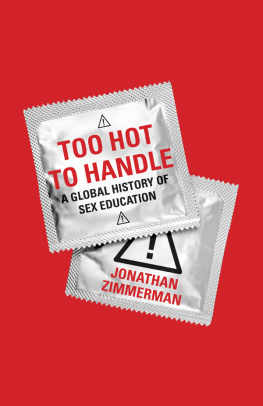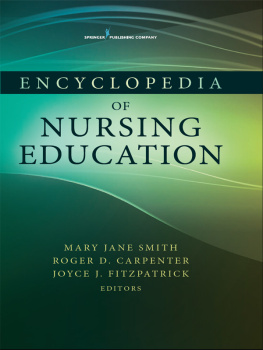
The Transformation of American Sex Education

The Transformation of American Sex Education
Mary Calderone and the Fight for Sexual Health
Ellen S. More

NEW YORK UNIVERSITY PRESS
New York
NEW YORK UNIVERSITY PRESS
New York
www.nyupress.org
2022 by New York University
All rights reserved
Frontispiece: Mary Steichen Calderone. Photo credit: Smithsonian Institution Archives.
References to Internet websites (URLs) were accurate at the time of writing. Neither the author nor New York University Press is responsible for URLs that may have expired or changed since the manuscript was prepared.
Library of Congress Cataloging-in-Publication Data
Names: More, Ellen Singer, 1946 author.
Title: The transformation of American sex education : Mary Calderone and the fight for sexual health / Ellen S. More.
Description: New York, N.Y. : NYU Press, 2022. | Includes bibliographical references and index.
Identifiers: LCCN 2021014419 | ISBN 9781479812042 (hardback) | ISBN 9781479812073 (ebook) | ISBN 9781479812059 (ebook other)
Subjects: LCSH: Sex instructionUnited StatesHistory. | Birth controlUnited StatesHistory | Calderone, Mary Steichen, 19041998. | Women social reformersUnited States. | Sex Information and Education Council of the U.S.
Classification: LCC HQ57.5.A5 M57 2021 | DDC 613.9071dc23
LC record available at https://lccn.loc.gov/2021014419
New York University Press books are printed on acid-free paper, and their binding materials are chosen for strength and durability. We strive to use environmentally responsible suppliers and materials to the greatest extent possible in publishing our books.
Manufactured in the United States of America
10 9 8 7 6 5 4 3 2 1
Also available as an ebook
Contents
My first and only encounter with formal sex education occurred sometime in the late 1950sin the living room of my parents house. I was in fifth or sixth grade. One morning I walked downstairs to find a book left for me on the sofa. When I picked it up, I discovered a fairly old volume, not too thick, about the reproductive anatomy of members of the animal kingdom. The chapters proceeded in ascending order of evolutionary complexity. Like most children on the threshold of puberty, especially children with more interest in people than in animals, I immediately skipped to the last chapter. What I found told me a lot about my fellow creatures, though not what I had expected to learn. The final chapter of this book explained the reproductive system of... horses. My disappointing introduction to sex education pales beside the experience of Dr. Mary Steichen Calderone (19041994), daughter of photographer Edward Steichen, prime mover in the transformation of modern sex education in the United States and worldwide, and one of the major figures in this story. Mary Steichens mother locked the young girls hands into metal mitts each night at bedtime, lest she use them for the horrible practice of masturbation. This was in the early twentieth century. Calderone, who trained as an actress in New York before becoming a physician, spent most of her adult life campaigning to free society of the fear and shame her parents imposed on her. At her death in 1994, the New York Times lauded her as the Grand Dame of sex education, but with all her poise and beauty, she was not above engaging in risky conversationeven with an audience of hundreds. She would, for example, open a talk with high school kids (this was in the 1960s) by asking for a four-letter word ending with the letter k that means intercourse. The correct answer was talk.
Who can explain the embarrassment and fears that have prevented so many parents from talking to their children about human sexuality? The effects of these silences are far reaching. As a column in the New York Times observed while I was completing this book, young men and women cannot even communicate with each other, much less with their parents, about sex. For a century or more, many (most?) American parents have lacked the ability to communicate with their children about humanitys two most basic functions, reproduction and sexuality. Sometimes, as with Mary Calderones mother, they have even resorted to threats or punishment to keep their children from learning about sex and the workings of their own bodies. The Transformation of American Sex Education is a history of Mary Calderones struggle to destigmatize human sexuality and of the movement she led to bring sexuality education and the idea of sexual health into American homes and schoolsa movement that outgrew Calderone herself and continues today.
In the 1960s, Calderone and the organization she cofounded in 1964, the Sex Information and Education Council of the United States (SIECUS), began a campaign to rejuvenate sex education and free it from its unhappy partnership with family life education. Calderone rapidly gained influence over many school officials and PTAs. Within five years, Calderone, SIECUS, and the issue itself became symbolic hostages of the culture wars. What should be the role of government in private life? In the public schools? What should be the place of religion in public life? Is premarital sex morally permissible? Will contraceptives lead to increased immorality? To whom should children turn for help in resolving these moral dilemmas? Such questions swirled around the problem of what to teach children about sex and who should teach it. This book seeks to trace the origins of todays conflicting approaches to sexual health and sex educationparticularly what is now known as comprehensive sex education.
Mary Calderone, known to many Americans from the 1960s until her death in 1998 as the grandmother of modern sex education, seems to have had little inkling of the fierce resistance that would greet her efforts. The issue of school-based sex education impinged on numerous cultural stress points increasingly dividing American society. The civil rights movement, the sexual revolution, the politics of the New Left, feminism, and the movement for gay rights (now understood as the rights of the LGBTQ+ community) all confronted whatever remained of Cold War fears and McCarthyism, an emergent New Right, and the move into overt political partisanship by white evangelicals. For the New Right, the specter of government-imposed sex education was the perfect symbol of the decay of American values.
This is a very different book from the one I envisioned writing when I first encountered Calderone. I met her in 1984, when I was beginning to research a history of American women physicians. (I will return to that encounter in chapter 1.) Even at the age of eighty, Calderone was an inspiring presenceI was sure I would eventually make her the subject of a biography. Yet, as compelling and complex a figure as she was, I have written a different book. Calderones story runs through it, certainly, as the inspiration for a movement that continues sixty years since the publication of her first book on the subject of healthy sexuality, Release from Sexual Tensions, in 1960. Even a cursory look at the history of modern ideas about sexual health and sexuality education reveals that Calderone was the herald of the movement. Yet sex education does not now, and never really did, bear the full imprint of her holistic vision of sexual health. A history of sex education in postWorld War II America and the emergence of comprehensive sex education begins with Mary Calderones campaign for sexual health, but does not end there.
Next page








